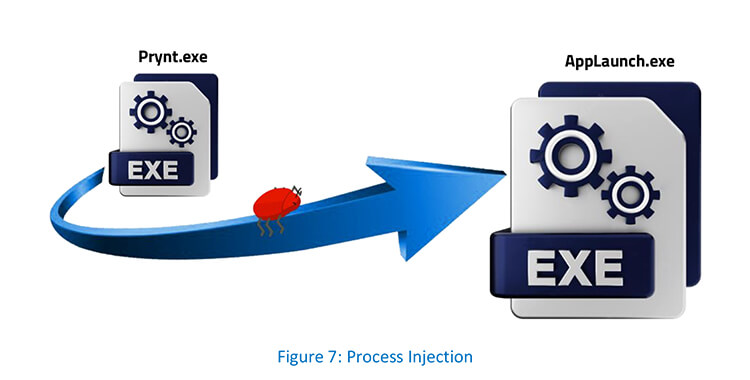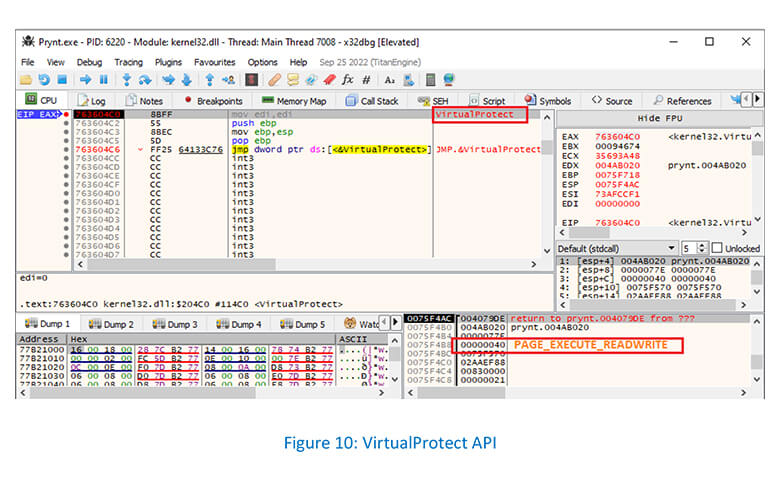



CYFIRMA Research team has seen an uptick in threat actor orchestrated cyber campaigns aimed at stealing confidential and sensitive information. Infostealers like “Prynt” are used to exfiltrate information as the first step leading into orchestration of sophisticated attacks which may include deployment of ransomwares.
In this report, we analyse infostealer “Prynt” which is often configured by the threat actors via a “builder” so that they can subsequently configure the malware easily. It may be noted that “Prynt” Stealer builder is used to create infostealer “Prynt” with a hidden backdoor functionality.
CYFIRMA Research team analysed an infostealer “Prynt” sample which was gathered from a public repository. The sample was found to be written in C/C++ and is a 32-bit console binary. Infostealer “Prynt” has the capability to steal system information from infected systems, which includes files from the targeted directories and credentials from web browsers.
In our analysis, we focus on the process injection technique leverage by the infostealer “Prynt” utilizing reverse engineering & memory forensics analysis, which involves injecting the infostealer “Prynt’s” malicious code into the legitimate AppLaunch.exe (Microsoft .NET ClickOnce Launch Utility) process; and later exits after injecting the code. Running the malicious code in the context of another process may allow access to the process’s resources like – memory, system, and network.
The infostealer “Prynt” has been observed to have the following capabilities:
Infostealer “Prynt” is a commodity malware and leveraged as part of Malware-as-a-Service (MaaS). In this case malware authors went ahead and wrapped up stealer with a backdoor even for their paying customers. The backdoor sends copies of victims’ exfiltrated data gathered by other threat actors to a private Telegram chat monitored by the Prynt Stealer developers.
Supported by our analysis, the infostealer “Prynt” evades detection using the process injection technique by injecting itself into a legitimate “AppLaunch.exe” process – which is a common technique used by malware. The Prynt Stealer builder used to create the infostealer “Prynt” has been derived from open-source code bases like AsyncRAT and StormKitty (an information stealer).
Such infostealer campaigns are used to exfiltrate confidential and sensitive information to resell for financial gains in dedicated forums and Telegram channels. Threat actors are also known to use various ways to distribute stealers, including – social engineering, phishing emails, compromised websites, and embedded images.
As part of CYFIRMA tracked campaigns observed in the last 6 month, we can see infostealer “Prynt” has been leveraged by threat actors originating from the following geographical regions (Confidence Level: Low):



CYFIRMA researchers while monitoring cybercriminal activities in the underground forums, noticed that a new version of the Prynt Advanced Stealer 4.2.2 is available on underground forums.


File: Prynt.Exe
Subsystem: Console
MD5: Bcd1e2dc3740bf5eb616e8249d1e2d9c
SHA1: 230f401260805638aa683280b86af2231cf73f93
SHA256: 04b528fa40c858bf8d49e1c78f0d9dd7e3bc824d79614244f5f104baae628f8f File Type: PE32 Executable (Console) Intel 80386, For MS Windows
File type of the Prynt.exe is a PE32 executable.

As can be observed, Prynt.exe is not packed.

As can be observed, Prynt.exe is written in C/C++.

Infostealer “Prynt” process injects malicious code into the legitimate AppLaunch process to hide its activity. Threat actors deploy the infostealer Prynt.exe in the victim’s environment with an aim to steal confidential and sensitive information.
Here we have analyzed the infostealer Prynt.exe on x64 Windows system.

Process injection is a technique which injects malicious code into another running process and the targeted process executes the malicious code. This technique conceals malicious behaviour of their code and may bypass firewalls and other process-specific security mechanisms. Prynt.exe authors used a combination of VirtualAlloc/VirtualAllocEx, VirtualProtect, and WriteProcessMemory APIs to inject code into a remote process.
The infostealer “Prynt” first creates an AppLaunch process to host the malicious code in suspended mode:

AppLaunch process in suspended mode as seen from Task Manager: –

Prynt process creates multiple threads via CreateRemoteThreadEx for establishing foundations for process injection and code execution. CreateRemoteThreadEx also creates a thread that runs in the virtual address space of another process.
VirtualProtect API used to change the permissions on a page in memory through PAGE_EXECUTE_READWRITE parameter: –

VirtualProtect API changes are noticed as RWX permissions at 0x4AB000 in the Memory tab of the Prynt process: –

Prynt process allocates new memory using VirtualAlloc API: –

Prynt is seen allocating new memory in a remote AppLaunch process using VirtualAllocEx API: –

Handles tab of the Prynt process showing the process handle value 0x33c90 associated with the AppLaunch: –

WriteProcessMemory API is used to write data into the allocated space :-

AppLaunch process was injected at 0x400000 address with PAGE_EXECUTE_READWRITE (RWX) permission:-

Prynt process calling SetThreadContext API to point the entry point to a new code section and run the injected code:-

Prynt resumes the suspended thread by calling NtResumeThread API to take the AppLaunch process out of the suspended state: –

Operating System: Windows 7 Service Pack 1 [SP1] (64-Bit)
A memory dump (RAM dump) win7sp1x64.raw was captured for memory analysis using WinPmem on x64 Windows 7 SP1 system.
Injected Process: AppLaunch.exe
Volatility plugin malfind was run against win7sp1x64.raw without specifying the -p option, it automatically identified the suspicious memory regions of all the processes running on the system based on the memory content and the VAD characteristics.
The dlllist plugin, which gets module information from the PEB, shows the full path to AppLaunch.exe (pid 215000).

The malfind plugin identified the suspicious memory protection at the address (0x400000) after running against the process AppLaunch.exe (pid 215000).

The vadinfo plugin confirms the suspicious memory region protection at the address (0x400000).

Regular loaded libraries in the address space of a process are of type _MMVAD (Vad) or _MMVAD_LONG (VadL) which represent memory-mapped files.
VadS (_MMVAD_SHORT) tag looks suspicious as it represents dynamically allocated memory pages created via VirtualAllocEx /WriteProcessMemory. But VirtualAllocEx API cannot allocate memory with PAGE_EXECUTE_WRITECOPY protection since the executable is loaded into memory with PAGE_EXECUTE_WRITECOPY protection by the operating system.
The volshell plugin’s db command dumps the content of the memory address 0x400000.

The AppLaunch process (pid 215000) was injected by allocating memory with the PAGE_EXECUTE_READWRITE permission.
Infostealer “Prynt” has been quietly used alongside RedLine stealer by the same set of Threat Actors to diversify their payloads. RedLine stealer has received a lot of criticism on the underground forums for being overpriced, so infostealer “Prynt” offers a cheaper alternative, which appears to be tested by Threat Actors. With time, if infostealer “Prynt” proves its utility during campaign deployment, we are likely to see a wider spread footprint, but at the moment it is yet to become a mainstream choice.
As shown in below graph, the infostealer “Prynt” stealer and RedLine stealer have common IP addresses in use – providing credibility to our analysis and hypothesis that slowly threat actors are shifting their focus towards infostealer “Prynt”.

Information stealers are prominent malware in the current threat landscape and provide an opportunity for cyber-criminals to steal confidential and system information which can be leveraged to conduct next stage of cyber- attacks like ransomware. Information stealers include backdoor programs, which open specific ports of the computer so the attacker can take control of the system.
Infostealer “Prynt” is configured through a builder and has a secret backdoor as part of the code which is further available in other variants. Infostealer “Prynt” uses process injection as a defence evasion technique and entails running malicious code within the address space of the legitimate process.
Organizations are advised to ensure that unnecessary ports and services are closed to prevent the risk of discovery and potential exploitation.
| Sr No. | Indicator | Type | Remarks |
|---|---|---|---|
| 1 | BCD1E2DC3740BF5EB616E8249D1E2D9C | MD5 | Prynt.exe |
| Sr No. | Tactic | Technique |
|---|---|---|
| 1 | Execution (TA0002) | T1106: Native API |
| 2 | Privilege Escalation (TA0004) | T1055: Process Injection |
| 3 | Defense Evasion (TA0005) | T1059: Hijack Execution Flow T1036: Masquerading T1112: Modify Registry |
| 4 | Discovery (TA0007) | T1082: System Information Discovery T1012: Query Registry |
| 5 | Command and Control (TA0011) | T1102: Web Service |